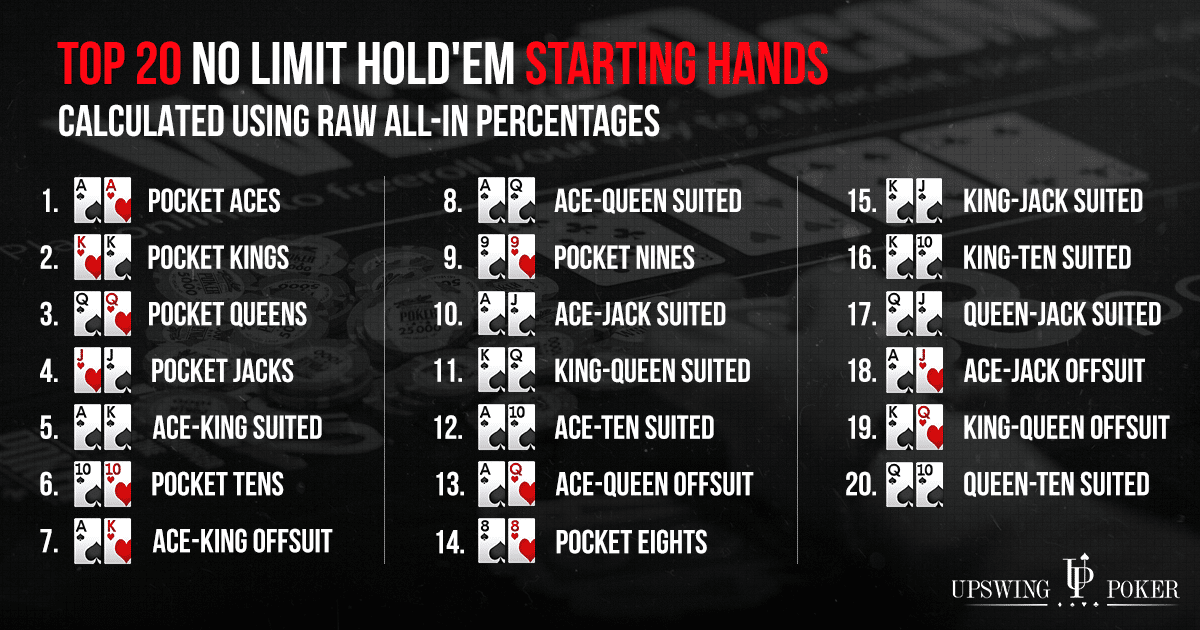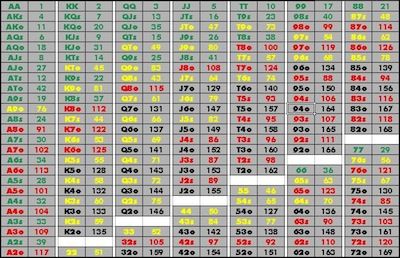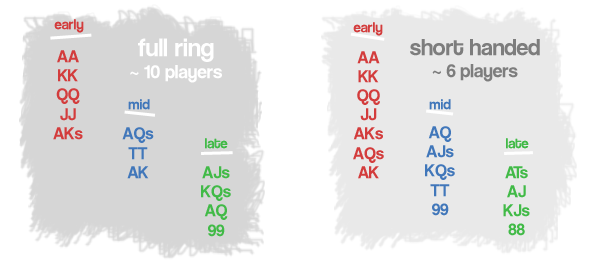Jul 23, 2019 Poker Hands Chart: Top 10 Starting hands in Texas Hold’em. As a starting point in determining which hands to play, it’s essential to know which ones are the best and why. Below is a chart of the Top 10 Starting Hands in Texas Hold’em: Starting Hands: The Power of High Cards.
In a Texas Holdem cash game, the chips you have in front of you are valued in real dollars, when you bet a $5 chip – that’s the equivalent of a real five bucks from your pocket. This means that decisions you make cumulatively win or lose you that money. Any player can hit some nice cards and walk away with a profit in the short-term. Over the long-run, successful players are those who understand and study poker strategy – finding weaknesses in their opponents play and betting in such a way as to take advantage of these weaknesses. This article covers the fundamentals of Texas Holdem cash game strategy, outlining the building blocks that you can use to consistently beat the games.
Texas Hold'em Strategy For Beginners
First up you will find information on the swings inherent in poker games and how to overcome this using bankroll management and focusing on making ‘good’ decisions. Next the fundamental concepts of position and starting hand selection are discussed. After this an overview of the need-to-know poker math – followed by some ideas for areas to explore once you have learned the basics.
Good Decisions And Variance
Poker has a large element of luck over the short-term. You can run Kings into Aces, lose those coin-flip hands and your drawing hands can miss. You could have played ‘correctly’ and still end up with a large loss.
Even the best players in the world suffer from short-term swings.
To counter this you need to make sure you only play with a small proportion of your bankroll in any one game. 1/20th (5%) is the accepted level to overcome the short-term swings. If you are able to easily reload your account then you can loosen up on this. However, if you are serious about your poker then bankroll management is an important factor.
All you can do in poker is make the best decisions possible based on the information you have available. If you do this over and over again, and manage your bankroll sensibly, then you will end up a winner.
Adjusting For Position
If 2 players of equal skill and experience sat down to play, the person who played more hands when they acted last after the flop would win in the long-run. This is known as having ‘position’ and is far more important than most new players realize.
Positional strategy includes folding speculative starting hands when first to act at the table, and playing more of these hands from the button position. You should also tend to play tighter from the blinds – even though it is ‘cheaper’ to enter the pot – since you will be first to act after the flop from these playing positions.
Starting Hand Selection in Texas Holdem Cash Games

A big leak for many beginning poker players is to play far too many hands. This can include any Ace-x hand, any 2 suited cards or even worse holdings! If your opponents are being more selective, then you would need to be a fantastic post-flop player to even come close to making up for this.
Instead you should find a tight range of starting hands and adjust this based on several factors. For early table positions and after someone already raised you should fold the weakest end or your range. When first to enter the pot and in late position you can loosen up a little bit.
Using Poker Math Strategy
It is extremely difficult to beat online poker games without knowing the basic math. Most of this is easy to learn – and even the advanced areas have special tools and calculators to help you out. There are several aspects of math to learn including pot-odds and outs, implied odds, prize pool equity models and how to assess what hands people are playing and the equity that individual hands have against those ranges.
Spending just a few hours learning the different aspects of poker math will have a huge effect on your profit – this will allow you to make more ‘good’ decisions and to spot those opponents who are making bad ones.

Advanced Concepts for Texas Holdem Cash Game Strategy
Once you have understood the basics of cash game strategy, you can start to branch out into the more advanced topics. First on my list is bet-sizing, and how to adjust this for specific situations and opponent types. After that you can focus on the process of reading your opponents hands – and spotting ‘leaks’ in both your own game and that of your opponents.
Remember, poker is a game of relative skill. However good you are, there will be people who can beat you. This holds true at all levels of the game, and if you take the time to find soft games with inexperienced opponents, your profits will improve significantly.
In the poker game of Texas hold 'em, a starting hand consists of two hole cards, which belong solely to the player and remain hidden from the other players. Five community cards are also dealt into play. Betting begins before any of the community cards are exposed, and continues throughout the hand. The player's 'playing hand', which will be compared against that of each competing player, is the best 5-card poker hand available from his two hole cards and the five community cards. Unless otherwise specified, here the term hand applies to the player's two hole cards, or starting hand.
- 2Limit hand rankings
Essentials[edit]
There are 1326 distinct possible combinations of two hole cards from a standard 52-card deck in hold 'em, but since suits have no relative value in this poker variant, many of these hands are identical in value before the flop. For example, A♥J♥ and A♠J♠ are identical in value, because each is a hand consisting of an ace and a jack of the same suit.
Therefore, there are 169 non-equivalent starting hands in hold 'em, which is the sum total of : 13 pocket pairs, 13 × 12 / 2 = 78 suited hands and 78 unsuited hands (13 + 78 + 78 = 169).
These 169 hands are not equally likely. Hold 'em hands are sometimes classified as having one of three 'shapes':
Texas Holdem Strategy Chart
- Pairs, (or 'pocket pairs'), which consist of two cards of the same rank (e.g. 9♠9♣). One hand in 17 will be a pair, each occurring with individual probability 1/221 (P(pair) = 3/51 = 1/17).
An alternative means of making this calculation
First Step As confirmed above.
There are 2652 possible combination of opening hand.
Second Step
There are 6 different combos of each pair. 9h9c, 9h9s, 9h9d, 9c9s, 9c9d, 9d9s
To calculate the odds of being dealt a pair
2652 (possible opening hands) divided by 12 (the number of any particular pair being dealt. As above)
2652/12 = 221
- Suited hands, which contain two cards of the same suit (e.g. A♣6♣). Four hands out of 17 will be suited, and each suited configuration occurs with probability 2/663 (P(suited) = 12/51 = 4/17).
- Offsuit hands, which contain two cards of a different suit and rank (e.g. K♠J♥). Twelve out of 17 hands will be nonpair, offsuit hands, each of which occurs with probability 2/221 (P(offsuit non-pair) = 3*(13-1)/51 = 12/17).
It is typical to abbreviate suited hands in hold 'em by affixing an 's' to the hand, as well as to abbreviate non-suited hands with an 'o' (for offsuit). That is,
- QQ represents any pair of queens,
- KQ represents any king and queen,
- AKo represents any ace and king of different suits, and
- JTs represents any jack and ten of the same suit.
There are 25 starting hands with a probability of winning at a 10-handed table of greater than 1/7.[1]
Limit hand rankings[edit]
Some notable theorists and players have created systems to rank the value of starting hands in limit Texas hold'em. These rankings do not apply to no limit play.
Sklansky hand groups[edit]
David Sklansky and Mason Malmuth[2] assigned in 1999 each hand to a group, and proposed all hands in the group could normally be played similarly. Stronger starting hands are identified by a lower number. Hands without a number are the weakest starting hands. As a general rule, books on Texas hold'em present hand strengths starting with the assumption of a nine or ten person table. The table below illustrates the concept:
Chen formula[edit]
The 'Chen Formula' is a way to compute the 'power ratings' of starting hands that was originally developed by Bill Chen.[3]
- Highest Card
- Based on the highest card, assign points as follows:
- Ace = 10 points, K = 8 points, Q = 7 points, J = 6 points.
- 10 through 2, half of face value (10 = 5 points, 9 = 4.5 points, etc.)
- Pairs
- For pairs, multiply the points by 2 (AA=20, KK=16, etc.), with a minimum of 5 points for any pair. 55 is given an extra point (i.e., 6).
- Suited
- Add 2 points for suited cards.
- Closeness
- Subtract 1 point for 1 gappers (AQ, J9)
- 2 points for 2 gappers (J8, AJ).
- 4 points for 3 gappers (J7, 73).
- 5 points for larger gappers, including A2 A3 A4
Texas Hold'em Tips And Tricks
- Add an extra point if connected or 1-gap and your highest card is lower than Q (since you then can make all higher straights)
Phil Hellmuth's: 'Play Poker Like the Pros'[edit]
Phil Hellmuth's 'Play Poker Like the Pros' book published in 2003.
| Tier | Hands | Category |
|---|---|---|
| 1 | AA, KK, AKs, QQ, AK | Top 12 Hands |
| 2 | JJ, TT, 99 | |
| 3 | 88, 77, AQs, AQ | |
| 4 | 66, 55, 44, 33, 22, AJs, ATs, A9s, A8s | Majority Play Hands |
| 5 | A7s, A6s, A5s, A4s, A3s, A2s, KQs, KQ | |
| 6 | QJs, JTs, T9s, 98s, 87s, 76s, 65s | Suited Connectors |
Statistics based on real online play[edit]
Statistics based on real play with their associated actual value in real bets.[4]
| Tier | Hands | Expected Value |
|---|---|---|
| 1 | AA, KK, QQ, JJ, AKs | 2.32 - 0.78 |
| 2 | AQs, TT, AK, AJs, KQs, 99 | 0.59 - 0.38 |
| 3 | ATs, AQ, KJs, 88, KTs, QJs | 0.32 - 0.20 |
| 4 | A9s, AJ, QTs, KQ, 77, JTs | 0.19 - 0.15 |
| 5 | A8s, K9s, AT, A5s, A7s | 0.10 - 0.08 |
| 6 | KJ, 66, T9s, A4s, Q9s | 0.08 - 0.05 |
| 7 | J9s, QJ, A6s, 55, A3s, K8s, KT | 0.04 - 0.01 |
| 8 | 98s, T8s, K7s, A2s | 0.00 |
| 9 | 87s, QT, Q8s, 44, A9, J8s, 76s, JT | (-) 0.02 - 0.03 |
Nicknames for starting hands[edit]
In poker communities, it is common for hole cards to be given nicknames. While most combinations have a nickname, stronger handed nicknames are generally more recognized, the most notable probably being the 'Big Slick' - Ace and King of the same suit, although an Ace-King of any suit combination is less occasionally referred to as an Anna Kournikova, derived from the initials AK and because it 'looks really good but rarely wins.'[5][6] Hands can be named according to their shapes (e.g., paired aces look like 'rockets', paired jacks look like 'fish hooks'); a historic event (e.g., A's and 8's - dead man's hand, representing the hand held by Wild Bill Hickok when he was fatally shot in the back by Jack McCall in 1876); many other reasons like animal names, alliteration and rhyming are also used in nicknames.
Notes[edit]

- ^No-Limit Texas Hold'em by Angel Largay
- ^David Sklansky and Mason Malmuth (1999). Hold 'em Poker for Advanced Players. Two Plus Two Publications. ISBN1-880685-22-1
- ^Hold'em Excellence: From Beginner to Winner by Lou Krieger, Chapter 5, pages 39 - 43, Second Edition
- ^http://www.pokerroom.com/poker/poker-school/ev-stats/total-stats-by-card/
- ^Aspden, Peter (2007-05-19). 'FT Weekend Magazine - Non-fiction: Stakes and chips Las Vegas and the internet have helped poker become the biggest game in town'. Financial Times. Retrieved 2010-01-10.
- ^Martain, Tim (2007-07-15). 'A little luck helps out'. Sunday Tasmanian. Retrieved 2010-01-10.
Comments are closed.